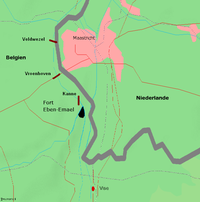Battle of Fort Eben-Emael
| Battle for Fort Eben Emael | |||||||
|---|---|---|---|---|---|---|---|
| Part of the Battle of Belgium in the Second World War | |||||||
 |
|||||||
|
|||||||
| Belligerents | |||||||
|
|
|
||||||
| Commanders and leaders | |||||||
|
|
|
||||||
| Strength | |||||||
| 493 | 1,200+ (estimated) | ||||||
| Casualties and losses | |||||||
| 44 killed 99 wounded |
60 killed 1,000+ captured |
||||||
German victory
The Battle of Fort Eben-Emael was a battle between Belgian and German forces that took place between 10 May and 11 May 1940, and was part of the Battle of Belgium and Fall Gelb, the German invasion of the Low Countries and France. An assault force of German paratroopers, Fallschirmjäger, was tasked with assaulting and capturing Fort Eben-Emael; a Belgian fortress whose strategic position and strong artillery emplacements dominated several important bridges over the Albert Canal. The easterly roads led into the Belgium heartland and the rest of the Low Countries. These roads were what the German forces intended to use to advance into Belgium. As some of the German airborne forces assaulted the fortress and disabled the garrison and the artillery pieces inside it, others simultaneously captured three bridges over the Canal. Having disabled the fortress, the airborne troops were then ordered to protect the bridges against Belgian counter-attacks until they linked up with ground forces from the German 18th Army.
The battle was a strategic victory for the German forces, with the airborne troops landing on top of the fortress via the use of gliders and using explosives and flamethrowers to disable the outer defences of the fortress. The Fallschirmjäger then entered the fortress, killing a number of defenders and containing the rest in the lower sections of the fortress. Simultaneously, the rest of the German assault force had landed near the three bridges over the Canal, destroyed a number of pillboxes and defensive positions and defeated the Belgian forces guarding the bridges, capturing them and bringing them under German control. The airborne troops suffered heavy casualties during the operation, but succeeded in holding the bridges until the arrival of German ground forces, who then aided the airborne troops in assaulting the fortress a second time and forcing the surrender of the remaining members of the garrison. German forces were then able to utilize two bridges over the Canal to bypass a number of Belgian defensive positions and advance into Belgium to aid in the invasion of the country. The bridge at Kanne was destroyed, forcing German engineers to construct a new bridge.
...
Wikipedia
